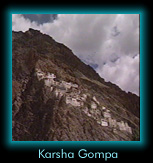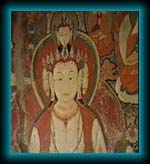
 Zanskar is a veritable Shangrila. Surrounded by extremely high mountains on all sides, it
could only be accessed through dangerous and high passes with an access window of a
few months only, during summer. The passes that ring Zanskar seem to echo out of
history..... Umasi la, the Poat la, the Kang la from the Miyar Nala near Udaipur, the
Shingola and further to the east the Phirtse la from the Sarchu plains. One of the most
popular routes in, is over the Shingola pass. At 17,200 feet on the crest of the actual Great
Himalaya range, the Shingo like the other high passes can only be crossed in late summer. The only
motor road into Zanskar is across the Pensi la from the Suru valley.
Zanskar is a veritable Shangrila. Surrounded by extremely high mountains on all sides, it
could only be accessed through dangerous and high passes with an access window of a
few months only, during summer. The passes that ring Zanskar seem to echo out of
history..... Umasi la, the Poat la, the Kang la from the Miyar Nala near Udaipur, the
Shingola and further to the east the Phirtse la from the Sarchu plains. One of the most
popular routes in, is over the Shingola pass. At 17,200 feet on the crest of the actual Great
Himalaya range, the Shingo like the other high passes can only be crossed in late summer. The only
motor road into Zanskar is across the Pensi la from the Suru valley.

 The Pensi on wards the comparative lushness of the Suru gives way to Zanskar's bleak
landscape which bye the way is also deceptive. Zanskar is home to myriads of high altitude
flower species, all the more striking in the general barrenness of the terrain. This is
a comparatively rare species - Aconitum Violacium. Aconite is the common name for
perennial herbs of the genus Aconitum and for a preparation derived from them that was
formerly used in medicine. The genus, with more than 100 species, belongs to the
Buttercup family and is native to temperate regions of the northern hemisphere.
The Pensi on wards the comparative lushness of the Suru gives way to Zanskar's bleak
landscape which bye the way is also deceptive. Zanskar is home to myriads of high altitude
flower species, all the more striking in the general barrenness of the terrain. This is
a comparatively rare species - Aconitum Violacium. Aconite is the common name for
perennial herbs of the genus Aconitum and for a preparation derived from them that was
formerly used in medicine. The genus, with more than 100 species, belongs to the
Buttercup family and is native to temperate regions of the northern hemisphere.
Aconites contain highly active alkaloids, especially aconitine, and are, inspite of their
beauty, poisonous to both humans and animals.
Zanskar, geologically, is a function of two river valleys which join to meet a third. The
Doda stream from the Pensi la meets up with the Lugnak near Padam to form the Zanskar
river. The Doda valley due to it's glacial origins is a fairly wide valley while the Lugnok
for most of it's course is a tremendous gorge
 As it's name translates, Zanskar, or Copper Star, was, in centuries past,
known throughout Ladakh and Western Tibet for it's whitish copper. This copper comes down
through Zanskar's many streams and rivulets and is extracted from the sediments, near the villages
of Zangla and Testa. This copper is used primarily for making vessels for religous and
domestic purposes.
As it's name translates, Zanskar, or Copper Star, was, in centuries past,
known throughout Ladakh and Western Tibet for it's whitish copper. This copper comes down
through Zanskar's many streams and rivulets and is extracted from the sediments, near the villages
of Zangla and Testa. This copper is used primarily for making vessels for religous and
domestic purposes.
The mainstay of life in Zanskar is the intense religiosity of the people and their relationship
to the monastery. There are 9 major Gompas or monasteries in Zanskar and dozens of
smaller village ones. Every Buddhist family is affiliated to some monastery situated near
the village. Usually, according to the lamaistic tradition, the youngest son from every
family is sent to the monastery as a novice lama.
The ties between the village and the monastery are bound not only by family linkages, but
socio-economic ties as well. No function, ceremony or celebration is possible without the
religous services of the lamas and even decisions like sowing seeds, harvesting etc, are
determined by the lamas, sometimes after consulting the appropriate oracle.
 It is in the great Gompas of Zanskar, that the cultural traditions of the people are made
manifest, and are preserved . Karsha is the largest Gelugpa monastery in Zanskar, it's
foundation attributed to the great translator Rinchen Zangpo. The Gelugpa are the
orthodox sect of Tibetan Buddhism owing allegiance to the Dalai Lama.
It is in the great Gompas of Zanskar, that the cultural traditions of the people are made
manifest, and are preserved . Karsha is the largest Gelugpa monastery in Zanskar, it's
foundation attributed to the great translator Rinchen Zangpo. The Gelugpa are the
orthodox sect of Tibetan Buddhism owing allegiance to the Dalai Lama.
Some of the best specimens of mural art in all of Zanskar, are found at Karsha. Housed in
a large structure called Labrang, access to which is through the roof, they represent five
different Buddha manifestations.
 This mural depicts the four headed Vairocana
This mural depicts the four headed Vairocana
The institutional structure of Tibetan feudalism was carried over to Zanskar and thus the
monasteries are substantive landholders. In Zanskar, where arable land is strictly limited, it
has made for another powerful link with the villagers, for most of these lands are
cultivated by them on behalf of the Lamas. The monastery recieves grain and butter in
return.
Butter, for the Trans-Himalayan peoples, has meanings not understandable easily by
others. Butter is energy source, as well as light source, for it fuels the countless little
lamps, found in all houses, and bigger ones in the monasteries. In the high, cold altitudes
that these people inhabit, butter is their most important source of dietary fat. Drunk in tea,
a misnomer, for it is more like a soup, with butter and salt, umpteen times a day.
Butter is also applied as a salve on wounds, and of course counts as the ultimate gift. The
most valued butter is made from Yak milk, which has a very high fat content.
The Zanskar economy still operates within the framework of a barter economy, dairy
products like butter being amongst their most valuable trade products.
 In winter , the Zanskar river is Zanskar's only access route, when the ice freezes thick on
the river, it becomes a highway known as the Chador road, straight to Saspul in the Indus
valley.
In winter , the Zanskar river is Zanskar's only access route, when the ice freezes thick on
the river, it becomes a highway known as the Chador road, straight to Saspul in the Indus
valley.


This page hosted by
 Get your own Free Home Page
Get your own Free Home Page
Web Page Design and Images Copyrightę: Karamjeet Singh


 Zanskar is a veritable Shangrila. Surrounded by extremely high mountains on all sides, it
could only be accessed through dangerous and high passes with an access window of a
few months only, during summer. The passes that ring Zanskar seem to echo out of
history..... Umasi la, the Poat la, the Kang la from the Miyar Nala near Udaipur, the
Shingola and further to the east the Phirtse la from the Sarchu plains. One of the most
popular routes in, is over the Shingola pass. At 17,200 feet on the crest of the actual Great
Himalaya range, the Shingo like the other high passes can only be crossed in late summer. The only
motor road into Zanskar is across the Pensi la from the Suru valley.
Zanskar is a veritable Shangrila. Surrounded by extremely high mountains on all sides, it
could only be accessed through dangerous and high passes with an access window of a
few months only, during summer. The passes that ring Zanskar seem to echo out of
history..... Umasi la, the Poat la, the Kang la from the Miyar Nala near Udaipur, the
Shingola and further to the east the Phirtse la from the Sarchu plains. One of the most
popular routes in, is over the Shingola pass. At 17,200 feet on the crest of the actual Great
Himalaya range, the Shingo like the other high passes can only be crossed in late summer. The only
motor road into Zanskar is across the Pensi la from the Suru valley.
 The Pensi on wards the comparative lushness of the Suru gives way to Zanskar's bleak
landscape which bye the way is also deceptive. Zanskar is home to myriads of high altitude
flower species, all the more striking in the general barrenness of the terrain. This is
a comparatively rare species - Aconitum Violacium. Aconite is the common name for
perennial herbs of the genus Aconitum and for a preparation derived from them that was
formerly used in medicine. The genus, with more than 100 species, belongs to the
Buttercup family and is native to temperate regions of the northern hemisphere.
The Pensi on wards the comparative lushness of the Suru gives way to Zanskar's bleak
landscape which bye the way is also deceptive. Zanskar is home to myriads of high altitude
flower species, all the more striking in the general barrenness of the terrain. This is
a comparatively rare species - Aconitum Violacium. Aconite is the common name for
perennial herbs of the genus Aconitum and for a preparation derived from them that was
formerly used in medicine. The genus, with more than 100 species, belongs to the
Buttercup family and is native to temperate regions of the northern hemisphere. As it's name translates, Zanskar, or Copper Star, was, in centuries past,
known throughout Ladakh and Western Tibet for it's whitish copper. This copper comes down
through Zanskar's many streams and rivulets and is extracted from the sediments, near the villages
of Zangla and Testa. This copper is used primarily for making vessels for religous and
domestic purposes.
As it's name translates, Zanskar, or Copper Star, was, in centuries past,
known throughout Ladakh and Western Tibet for it's whitish copper. This copper comes down
through Zanskar's many streams and rivulets and is extracted from the sediments, near the villages
of Zangla and Testa. This copper is used primarily for making vessels for religous and
domestic purposes. It is in the great Gompas of Zanskar, that the cultural traditions of the people are made
manifest, and are preserved . Karsha is the largest Gelugpa monastery in Zanskar, it's
foundation attributed to the great translator Rinchen Zangpo. The Gelugpa are the
orthodox sect of Tibetan Buddhism owing allegiance to the Dalai Lama.
It is in the great Gompas of Zanskar, that the cultural traditions of the people are made
manifest, and are preserved . Karsha is the largest Gelugpa monastery in Zanskar, it's
foundation attributed to the great translator Rinchen Zangpo. The Gelugpa are the
orthodox sect of Tibetan Buddhism owing allegiance to the Dalai Lama. This mural depicts the four headed Vairocana
This mural depicts the four headed Vairocana
 In winter , the Zanskar river is Zanskar's only access route, when the ice freezes thick on
the river, it becomes a highway known as the Chador road, straight to Saspul in the Indus
valley.
In winter , the Zanskar river is Zanskar's only access route, when the ice freezes thick on
the river, it becomes a highway known as the Chador road, straight to Saspul in the Indus
valley.

